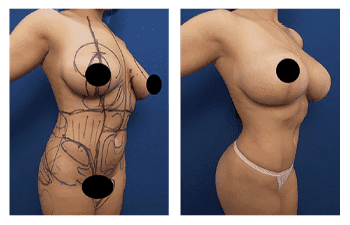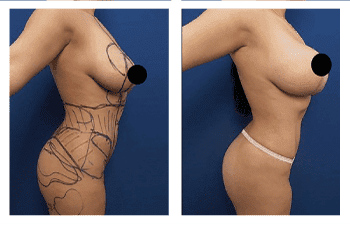

Please admire this 25-year-old female who has successfully undergone buttock augmentation with VASER high-definition liposuction of the back, medial thigh, and lateral thighs and fat transfer to the buttocks.
Buttock augmentation risks depend on the augmentation technique chosen for the patient desiring buttock enhancement. Patients who possess minimal fat or desire accentuation of their buttock projection are recommended buttock augmentation using a buttock implant. The number one buttock augmentation risk using butt implants is implant extrusion.
This is because the buttock is under much physical compression and shear force. As such, the placement of a solid foreign element is constantly vulnerable to these shear forces. To minimize the risks of extrusion, implants are placed within the major gluteus muscle. However, if implants are chosen that are too large to fit completely within the major gluteus muscle, then extrusion becomes a concern. This is, in fact, a very common problem, with early reports as high as one in five buttock implant extrusions occurring throughout the nation.
For those patients who desire a Brazilian Butt Lift that involves only the use of fat transfer, risks are less prevalent. More common risks following this cosmetic surgery include partial fat injection take, which may result in uneven buttock contour or subtle asymmetry in buttock shape. Several surgical maneuvers are employed to ensure optimum fat graft take and BBL outcomes. Although the risk of complication is less frequent, the potential risk of a detrimental fat embolism is a reality as such specific protocols are followed to minimize the risk of inadvertent injection of fat under the gluteus maximus muscle where fat emboli may occur.
Factors Increasing Buttock Augmentation Risks
The reason for the high rate of complication following the surgical procedure of butt implants is that patients are demanding to have implants that are larger than what can be accommodated by their gluteus muscle. As such, it is imperative that buttock specialists accurately measure the buttock dimensions and unequivocally prevent patients from choosing buttock implants that are too large for their gluteal muscle.
Accurate intramuscular dissection and selection of conservative buttock implant sizes that comfortably fit inside the muscle are critical to minimizing buttock augmentation risks. Another option for buttocks augmentation includes fat transfer, coined the Brazilian buttock lift, which can be performed in patients who possess adequate amounts of the fat reserve.
With the advent of ultrasound-assisted liposuction, patients are now taking advantage of the improved ability to harvest fat for fat transfer. VASER liposuction can harvest, on average, 40 % fatter than traditional techniques, thus allowing more patients to take advantage of using their fat for buttocks augmentation. Other maneuvers employed to improve fat graft take include minimizing the out-of-body time for the extracted fat cells to less than 1/2 an hour. This requires streamlining your fat collection, processing, and reinjection techniques. We employ a closed-loop fat harvest and injection technique that helps optimize fat graft viability during Brazilian Butt Lift surgeries. The closed-loop system also minimizes the risk of infection by eliminating any potential for fat cells to be exposed to the outside environment.
The most feared complication of the Brazilian buttock lift remains a fat embolus which refers to the fact that fat cells being transplanted into the buttocks can get into the bloodstream and end up clogging vessels downstream.
If a fat globule clogs vessels in the lungs, this is called a pulmonary embolus, which can have a detrimental effect. Many preventive steps have been developed to avoid fat emboli, including a recommendation by the American Society of Plastic Surgeons to avoid intramuscular buttock fat grafting of the major gluteus muscle. The most helpful technique today is to use a portable ultrasound that allows for fat transfer under direct visual guidance. By identifying danger zones and getting the lay of the land, it is possible to minimize this risk.
With precaution and appropriate surgical design and implementation, buttock augmentation risks are typically avoided. Patients can be assured that they will avoid many risks of buttock augmentation, such as contour deformities, loss of skin sensation, and more detrimental risks. A final recommendation to patients who undergo cosmetic surgeries is to avoid weight gain, which can also affect the final contour created by your Surgisculpt surgeon.

